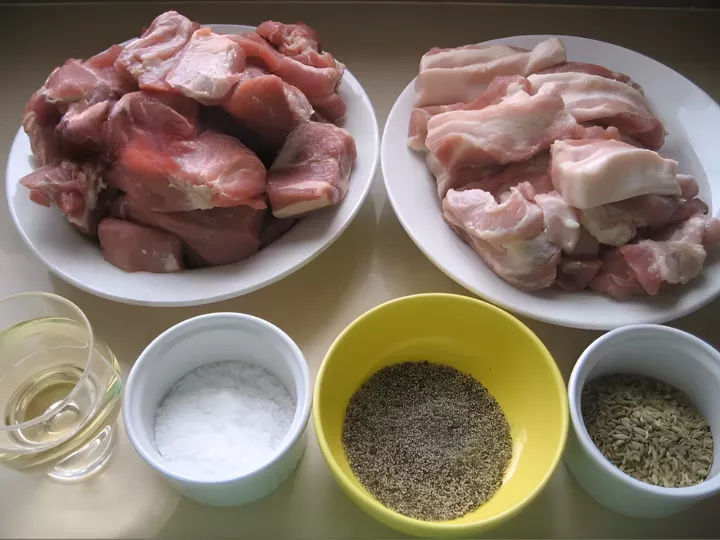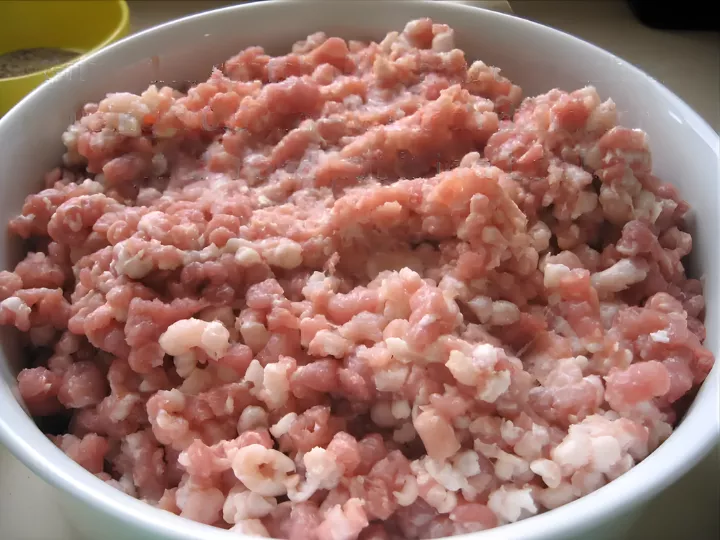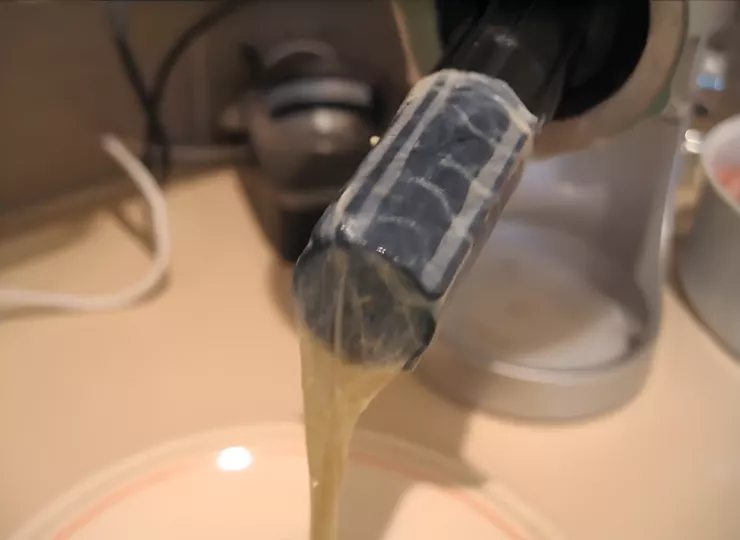Fire up the grill for Homemade Sicilian Pork Sausage with Fennel. Juicy, flavourful, and easy to cook, it’s made for outdoor meals and relaxed gatherings.

Few recipes take me back to my family’s kitchen quite like Homemade Sicilian Pork Sausage with Fennel. It’s something I’ve been making for years and have always wanted to share here, waiting only for the right moment (and better photos!). At last, the time has come, and we are still perfectly within the Northern Hemisphere grilling season.
For my friends in the Southern Hemisphere, do not worry. I will soon share another way to enjoy this wonderful sausage without lighting up the barbecue.
The best Sicilian fennel sausage I have ever tasted was in San Vito Lo Capo, where the local butchers are well known for it. When my dad was young, he became friends with one of the first butchers in town and often watched him make it. This is the same recipe he later passed on to me, simple, traditional, and full of character.
This Fennel and wine sausage is preservative-free, easy to prepare, and full of genuine flavour. Once you have made your own, I doubt you will ever want to buy sausage again!
I hope you enjoy it, and while you’re here, have a look at my other regional Italian recipes!
What Is Italian Fennel Sausage
Italy is famous for its sausages, and every region makes them in its own way. Order one in the North, and you will probably get something quite different from what you find in the South. They might look similar, but the flavour is never the same. Most are made with pork, yet the seasonings and spices change from place to place, reflecting local tastes and traditions.
In the North, sausages sometimes have a hint of cinnamon, while in the South, they are often spiced with black pepper or chilli. Then there is the Sicilian fennel sausage, known in Italy as salsiccia al finocchietto. What makes it special is the fennel seeds, which give it an unmistakable Sicilian flavour.
This sausage is made from coarsely ground pork mixed with salt, pepper, and plenty of fennel seeds. In Sicily, wild fennel grows everywhere, and its sweet, slightly aniseed taste goes perfectly with the richness of the meat. Some butchers add a little wine or a pinch of chilli for extra depth, but the fennel is always the main flavour.
Sicilian fennel sausage is very versatile. You can grill it, cook it in a pan, or crumble it into a tomato sauce to serve with pasta.
Why This Pork and Fennel Sausage Is a Favourite in My Kitchen
- You can make it in advance and freeze the sausages for quick meals later on.
- Everything needed is easy to find, and there are no preservatives or unnecessary additives.
- It’s delicious on its own, sliced in sandwiches, or added to pasta sauces and risotto.
Key Ingredients for Sicilian Pork Sausage with Fennel

Meat
A mix of pork scotch fillet and pork rashers gives the right balance between lean and fat. The scotch fillet provides structure and flavour. The rashers add moisture and richness to keep the sausage tender and juicy after cooking.
Fennel Seeds
The signature ingredient of Sicilian sausage. They add a soft, fragrant sweetness that works perfectly with the natural richness of the pork.
Wine
Both red and white wine work well. It adds depth to the flavour and helps blend the seasonings evenly through the meat.
Find the complete list with measurements in the recipe card below.
How to Make Homemade Sicilian Pork Sausage with Fennel
Step 1: Roughly chop the scotch fillet and the rashers.
Step 2: Grind the scotch fillet and rashers using a grinder fitted with a 0.5 cm – 0.2 inch plate.

Step 3: Put the ground meat in a bowl. Add the salt, wine, fennel seeds, and ground pepper, and knead well.

Step 4: Stuff the sausage into the casing and tie it off with a bubble knot.

Step 5: Let it dry in the fridge overnight before cooking (or freezing) it.

Frequently Asked Questions
Yes, but choose a mix of lean and fatty meat to keep the sausage juicy and tender. Pork shoulder works well because it naturally has the right fat balance. Avoid using very lean cuts on their own, as the sausage can turn dry when cooked.
Yes, you can shape the mixture into patties or small rolls and cook them like burgers. The flavour will stay the same, but the texture will be slightly different without the traditional snap of the casing. It’s a great option if you do not have the equipment for stuffing.
Both are traditional choices. Red wine gives a stronger, deeper flavour, while white keeps the sausage fresher and lighter. If you are using spicy fennel seeds or adding chilli, red wine pairs well with those stronger flavours.
Extra Help from the Kitchen
Dry Casings Properly – After soaking, pat the casings dry before stuffing. This prevents slipping and helps the sausage hold its shape more easily.
Use Cold Equipment – Keep the grinder and bowl chilled before use. Cold tools prevent the fat from melting too early, keeping the texture firm.
Twist Links Evenly – When tying the sausage, twist each link in the opposite direction from the previous one to keep them secure and prevent the links from coming apart during cooking.
Avoid Overfilling – Do not pack the sausage casings too tightly, as they can split during cooking. Leave a bit of room for the meat to expand.

Variations and Twists
Spicy Calabrian Style – Add crushed chilli flakes for gentle heat inspired by southern Italy. It gives the sausage a warm depth of flavour without taking away from the fennel.
Garlic and Wine – Mix in finely minced garlic and a splash of extra wine for a deeper flavour. The garlic enhances the pork, and the wine helps the seasoning spread evenly through the meat.
Cheese and Herb – Add small cubes of pecorino and a few leaves of chopped parsley for a rich, savoury variation. The cheese softens during cooking and adds a pleasant saltiness to every bite.
Lemon and Fennel – Grate a little lemon zest together with the fennel seeds to lift the flavour. This version has a lighter taste that works especially well when grilled.
Storage and Shelf Life
Store the raw sausage in an airtight container in the fridge for up to 2 days. For longer storage, wrap it in foil and place it in a Ziploc bag before freezing. It can be kept frozen for up to 3 months.
When ready to cook, thaw it in the fridge overnight. Once cooked, refrigerate leftovers in a sealed container for up to 3 days. Reheat gently in a pan or on the grill until warmed through.


Homemade Sicilian Pork Sausage with Fennel
Fire up the grill for Homemade Sicilian Pork Sausage with Fennel. Juicy, flavourful, and easy to cook, it’s made for outdoor meals and relaxed gatherings.
Ingredients
- 800 g – 1.75 lbs pork scotch fillet
- 400 g – 0.9 lbs pork rashers – skin removed
- 20 g – 1.25 tbsp salt
- 2 tbsp fennel seeds
- 115 ml – ½ cup red or white wine
- 1 tbsp freshly ground pepper
- Edible sausage casing
Instructions
-
Roughly chop the scotch fillet and the rashers.
-
Grind the scotch fillet and rashers using a grinder fitted with a 0.5 cm – 0.2 inch plate.
-
Put the ground meat in a bowl. Add the salt, wine, fennel seeds, and ground pepper, and knead well.
-
Stuff the sausage into the casing and tie it off with a bubble knot.
-
Let it dry in the fridge overnight before cooking (or freezing) it.
Recipe Notes
Freeze the sausage for up to 3 months. Wrap it tightly in foil and place it in a Ziploc bag to keep it fresh.



















Such artisanship. I don’t even eat pork and I am drooling over this. 🙂
What a great recipe, hubby would love to grill some!! I have on my to do list to make homemade sausage. It looks fun to make! Hugs, Terra
Yum. My parent have been making these here in Sydney for years.
I know sometime my papa uses his wild fennel leaves instead
of fennel seeds or aniseed seeds (he reckons they are closer to wild
fennel seeds in sicilia…boh???) I know around Catania they call
these SALSICCIA AL CEPPO- because they mince the
pork with a knife on a tree stump(ceppo).
This looks fantastic Manuela! i always shy away from making sausage because I don’t want to deal with the casings. But I love fennel sausage albeit a bit spicier. must give it a try!!
Casings can be a difficult and a little intimidating. However after a little patience and love they can be easily cleaned and washed.
1. Put them in cold water to soak for an hour or so. (no firm time, I just do this to ensure all salt removed.
2. Sometimes they are turned the right way when you buy them (check to see where the little strands are. If on the outside they are the right way. If not, you will have to turn them inside out. Find the end and fill with water and they will do the work themselves). Wash them three times once they are right side out. Just run water through them and press the water out. No need to make long long strande. Cut them after 4ft to make it easier.
3. Put washed casings in a seperate bowl and cover with water and refridgerate until needed. Casings should be easily seperated if washed properly when you need them.
4. Left over casings can be reused later if you package them in a plastic bag and salt. Add lots of salt and then place them back in the freezer.
Hopefully this helps.
OMG! This is how my daddy use to make sausages. So authentic! This looks fantastic!!! I am so trying this. I know my Home and Family viewers will love this!!!!
I formulate sausages for our own food business and this caught my attention and intense interest. I definitely will try it and come out with a new variety here in Philippines. Thank you very much. Your pic looks so tempting. Great!
Brilliant! Great recipe. Explained n detail with amazing pictures. I like sausages so much. I like all meals with the meat included. Great work. Well done! Andrew!
Can I stuff the casings by hand or do I need sausage stuffing attachment on my Kenwood? Also, can I chop by hand or do I need a grinder/mincer?
Thanks Manu. Yours is the best food/recipe site ever!! Love it.
Hi Steph! Thanks!! 🙂
The answer is yes to both questions. No need for fancy attachments, you can stuff the casings by hand (I have seen it done with a Chinese soup spoon).
Also, traditionally, Italian sausage is made by chopping the meat with a knife, so definitely go for it!
Let me know how you like it, this is my favourite sausage EVER!
Hi Manu,
When you say Pork Rashers, do you mean bacon, or something else?
Thanks
Hi Kathryn. If you are in Australia, it’s basically pork belly but it’s sold in thick slices. Otherwise, normal pork belly works fine too. 🙂
Ok, thanks! I did make them with bacon, but it came out incredibly salty. I had to add another 500gms of pork mince to dilute it, but they were delicious!
Okay, rashers are pork belly but what’s pork scotch fillet?
I am not sure of the exact name outside of Australia, but pork shoulder would work great for this recipe.
Beware of the FENNEL PERIL.
For many people FENNEL and PORK are a perfect combination. Be wary, fennel has a strong flavour and, personally, tends to over-power the other ingredients. The beauty of making your own sausages is that you have used the freshest and best ingredients and you are consuming a preservative free delicacy. So, unless you are a FENNEL devotee, I would experiment with the addition of Fennel so as to not lose the exquisite flavours of natural home made pork sausages.
TO THOSE WHO ASKED;
Pork Scotch Fillet, ‘Coppa’ in Italian, also known as Pork Neck or, more rarely, Collar Butt. This cut is located behind the back of the head and the top of the shoulder. This cut is good for roasting or casseroles and stays moist during slow cooking. Used to make the Italian smallgood CAPOCOLLO.
Pork Scotch Fillet, ‘Coppa’ in Italian, also known as Pork Neck or, more rarely, Collar Butt. This cut is located behind the back of the head and the top of the shoulder. This cut is good for roasting or casseroles and stays moist during slow cooking. Used to make the Italian smallgood CAPOCOLLO.
Paul, I am a Destefano also (my paternal grandmother). My father was from the town of Meduno in Friuli. I like your comments re fennel, since as a child I did not like it in my sausages, …but now that I’m much older, and my palate is not as sensitive as it once was, I enjoy it immensely. Salute.
I have been working on sausage recipes for years and yours looks interesting. I would not have tried pork belly so anxious to try that. Have you tried toasting the fennel seeds?
Every white wine is so different, has such a unique flavor from each other. You don’t mention which white wine you prefer to use? And have you tried cooking sherry?
Fantastic recipe second time using it but have added some chilli powder.
Dear Manu, I see you have many comments/questions in this Sicilian Sausage section, …so I’m going to ask: do you ever make this sausage with garlic in addition to the other ingredients?
Looks like a great recipe that I will definitely try soon, since here in SW Montana our winter weather keeps us indoors, This is the perfect time for sausage-making. Thank you for your great site.
Hi Richard. You can add some garlic if you like. This is the recipe I got (through my father) from a Sicilian butcher and he doesn’t use any. However, feel free to try it!
Hi Manu – This looks amazing – I’m looking forward to giving it a try. Just to confirm – it is 2 TABLESPOONS of fennel seeds and not 2 TEASPOONS? With Thanks
Hi Jerry! Yes, it is 2 tablespoons. However, you can play around with the amount and adjust it to your liking. 😉 Enjoy and let me know how you like it!
Thanks Manu – I used the amounts you specified (but halved the salt) and it was a real hit with my family! Definitely doing this regularly! Cheers, Jerry